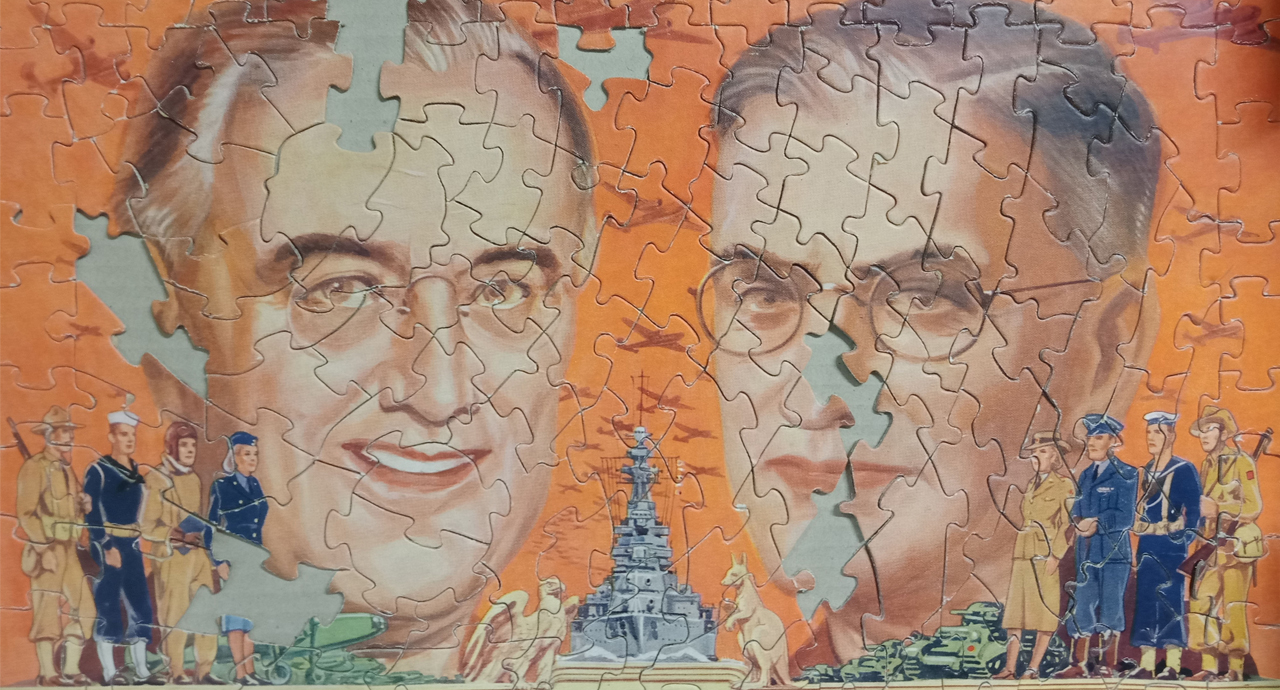
United in Victory - A timely donation to the Children’s Literature Research Collection
Recently an old envelope arrived with some dusty old jigsaw pieces and a cryptic note. We completed the puzzle and it turned out to be ‘United in Victory’ a World War II image of US President Franklin Delano Roosevelt and the Australian Prime Minister John Curtin published by John Sands, Sydney in 1942.
 Image caption: United in Victory interlocking jigsaw, 1942. Part of the Children's Literature Research Collection.
Image caption: United in Victory interlocking jigsaw, 1942. Part of the Children's Literature Research Collection.
In 1941 John Curtin declared war on Japan after the bombing of Pearl Harbour and escalating Japanese hostilities in the Pacific. Curtin knew he could not rely on British help so appealed publically for US support to the apparent astonishment of Roosevelt. Just weeks after Curtin’s declaration Japan bombed Darwin and Australia was under the very real threat of invasion. The cryptic note with the jigsaw, which read, 'I thought you might enjoy this article for a joke; a) what a farce; b) Johnny come-lately', reflects the cynicism around America’s belated entry into the War and the level of their actual commitment to supporting Australia in light of their own sudden need for Pacific outposts and safe bases in Australia.
The puzzle is a typical patriotic Australian child's jigsaw created as part of government efforts to gain public acceptance for the sudden influx of a large number of American servicemen. The use of many different coloured printing dyes is unusual given the rationing of ink during the War but indicates the importance of the message and the need to diffuse public resentment of the better-resourced American forces.
As this year is the 75th anniversary of the surrender of Imperial Japan (15 August 1945) after the US detonated atomic bombs over the Japanese cities of Hiroshima and Nagasaki, this jigsaw reminds us of the goings on at the time and also how neither of these respected men lived to see the actual end of the War. By April 1945 Roosevelt, always in poor health and a life-long chain-smoker, was finally done in by the Yalta Conference in the Crimea and Stalin’s betrayal of the decisions they made there. He had aged rapidly and died of a stroke soon after his return to America. By July 1945 Curtin, who had fretted, smoked heavily and paced nightly over the decisions he'd made risking the lives of more Australian service personnel, died following a heart attack.
It must have been very unsettling for both the US and Australia to see their leaders die when the War in the Pacific was still underway albeit in the Allies’ favour, and without knowing of the US plans to force a Japanese surrender.
Huge crowds packed Martin Place in Sydney to celebrate the Japanese surrender after the announcement made by the new Prime Minister Ben Chifley, a friend to Curtin. After the streamers settled it was a sombre occasion for those who lost so much to the war in some way or were forever damaged by it, which was probably nearly everyone.
The Australian War Memorial has a complete jigsaw and the Australian National Maritime Museum holds the packet in which it was distributed, and we also hold the guide-sheet. So between the three institutions we have a complete set to reflect our nation’s War history. The Children’s Literature Research Collection also holds a jigsaw of General Douglas MacArthur from 1940 which is similar in design elements and the tendency to patriotism and propaganda.
United in Victory is worn out and there are pieces missing, perhaps not unlike the folks left behind to carry on after six gruelling years of conflict.
Written by Denise Chapman, Curator, Access and Engagement, 2020